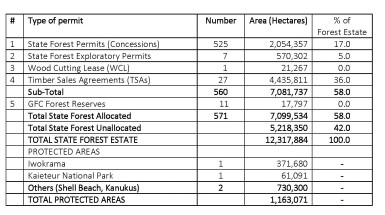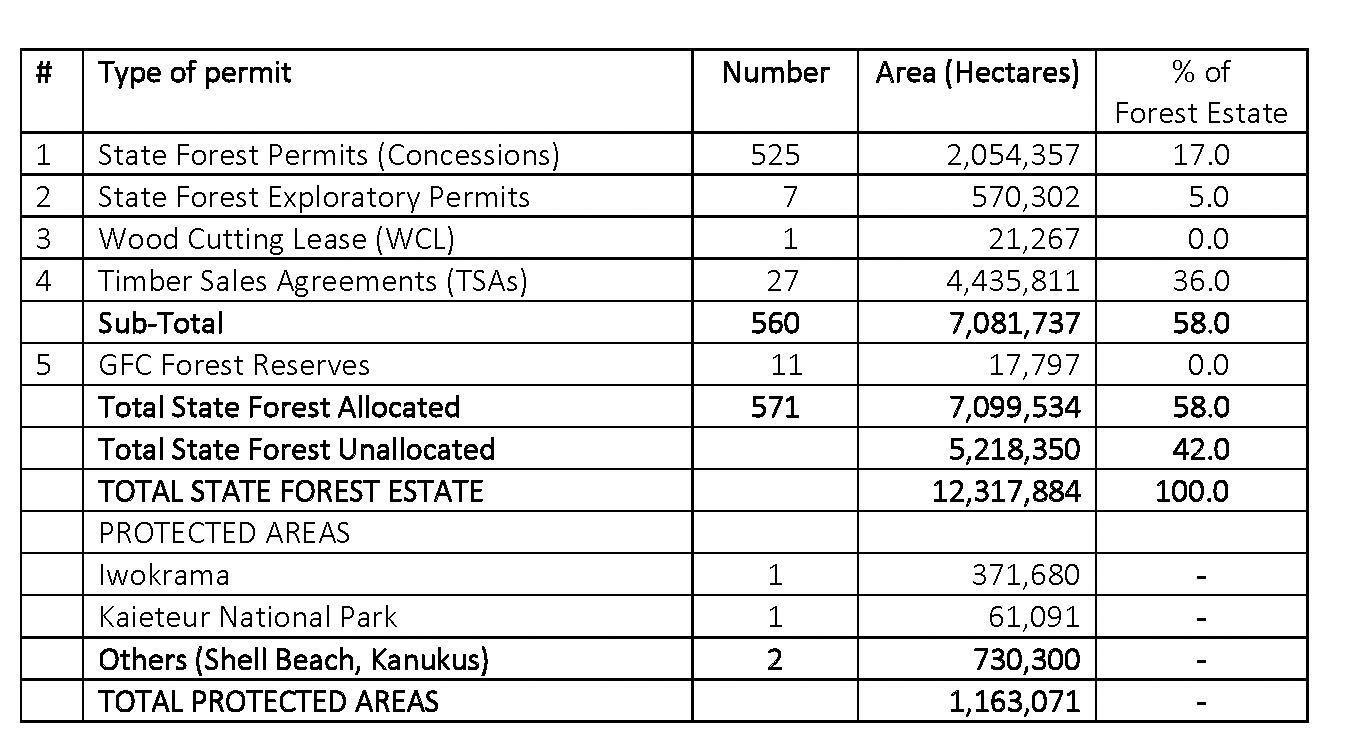 Guyana has a total area of 21 million hectares of which 18.3 million hectares, or 87%, are covered by forest. Of the latter amount, 12.8 million hectares comprise State Forest administered by the Guyana Forestry Commission (GFC). The majority of the other 5.5 million hectares is owned and administered by Amerindian communities while the remainder falls under the jurisdiction of the Guyana Lands and Survey Commission.
Guyana has a total area of 21 million hectares of which 18.3 million hectares, or 87%, are covered by forest. Of the latter amount, 12.8 million hectares comprise State Forest administered by the Guyana Forestry Commission (GFC). The majority of the other 5.5 million hectares is owned and administered by Amerindian communities while the remainder falls under the jurisdiction of the Guyana Lands and Survey Commission.
The sustainable management and conservation of forest resources are regulated by the Forests Act 2009 which was passed in the National Assembly on 22 January 2009. However, it was not until 12 October 2010 that the then President assented to it, and the concerned Minister did not sign the related Order to bring the Act into operation until 8 August 2012. The predecessor Act was the Forests Act 1953, as amended from time to time.
Forest concessions and permits
 A State forest authorization is an exploratory permit, a concession, a use permit, an afforestation agreement, or a community forest management agreement. These authorisations/permits do not give exclusive right of occupation over the area unless specified in the authorization. Nor do they permit the holder to occupy or take forest produce from any land that is lawfully occupied by any person or group. Where such an authorization is in force in respect of any forest produce, no other authorization can be granted in respect of the same kind of forest produce in that area.
A State forest authorization is an exploratory permit, a concession, a use permit, an afforestation agreement, or a community forest management agreement. These authorisations/permits do not give exclusive right of occupation over the area unless specified in the authorization. Nor do they permit the holder to occupy or take forest produce from any land that is lawfully occupied by any person or group. Where such an authorization is in force in respect of any forest produce, no other authorization can be granted in respect of the same kind of forest produce in that area.
The Commission grants four main types of permits, namely, State Forest Exploratory Permit (SFEP); State Forest Concession (large and small); Wood Cutting Lease; and Timber Sales Agreement (TSA). A small concession covers an area of less than 8,097 hectares (approximately 20,000 areas or 31 square miles) while a large concession is in excess of 8,097 hectares. As at May 2015, 45% of the concessions granted relates to foreign ownership while 26% represents local ownership. Small concessions to local owners account for 23% while allocations to local communities amounted to 6%. The following table gives a summary of the various types of permits in force:
State Forest Exploratory Permit
A person may apply for the grant of a permit to carry out exploratory operations within a specified area of State forest with a view to subsequently applying for a concession in that area. The application for a State Forest Exploratory Permit (SFEP) must be in response to a public notice or other forms of publicity, as the Commission deems necessary to bring to the attention of persons interested in applying for an exploratory permit.
An applicant for an SFEP is required to pay a non-refundable application fee of US$20,000; must have audited financial statements for the last five years; provide evidence of technical and financial qualifications; and a history of compliance. If the Commission is satisfied that an applicant meets these requirements, it invites the applicant to submit a bid specifying the premium he/she is offering to pay for the permit. The premium must be above the minimum value specified by the Commission. If more than one applicant qualifies, the permit is granted through negotiations with the qualified applicants, or the permit is offered through competitive bidding in accordance with the regulations.
If the Commission approves of an application for a SFEP, the application is forwarded to the Cabinet Sub-Committee on Natural Resources for endorsement. Once the permit is granted, the holder is only allowed to cut and take specified kinds and quantities of forest produce from the exploratory area for testing, research and limited commercial purposes to the extent necessary to recoup no more than the appointed percentage of the expenses incurred in the exploratory operations during the life of the permit. Appointed percentage is defined as the percentage prescribed by regulations, or where no percentage is prescribed, 25 per cent. Capital expenditure, such as the purchase of vehicles and equipment, is excluded from the computation.
An exploratory permit expires on the earlier of the expiry date contained in the permit or on the third anniversary of the permit. In other words, an exploratory permit is valid only for a maximum of three years. The law does not allow for the renewal of such a permit. However, while the permit is in force, the holder may apply for a concession in respect of all or part of the exploratory area. Within the three-year period of the SFEP, the holder is also required to have a Management Level Forest Inventory and a Forest Management Plan, and to carry out an Environmental and Social Impact Assessment (ESIA).
State Forest Concession
Persons may apply to the Commission for the grant of a forest concession. The Commission’s Forest Resources Allocation Committee reviews the application and makes a recommendation to the Commissioner. The application is further reviewed by the Technical Sub-Committee of GFC’s board which makes a recommendation to the full board for final approval.
A concession is granted if the Commission determines that the applicant: (a) meets the financial and technical requirements in addition to history of compliance; and (b) has good faith intention as well as the competence and resources. The expiry date of a concession is per agreement or for 40 years whichever is earlier. There is provision for the renewal only if the holder does not default in the earlier agreement. A large concession is only granted if the applicant is the holder of an exploratory permit; or if the applicant has satisfied compliance and other requirements to carry out forest conservation operations in the area concerned. A key requirement is for there to be in place a forest management plan of at least five years’ duration as well as an annual operations plan, duly approved by the Commission.
Use Permit
Persons may apply to the Commission for the grant of a Use Permit to carry out one or more of the following: scientific research; education training; recreation or eco-tourism; taking photographs, making films or videos and sound recordings; or any other purpose after public notification. The permit is granted after due consultation with the relevant stakeholders. The holder of a Use Permit cannot cut or take any forest produce unless needed for bone fide scientific research or other specified purposes, in which case the permit will specify the quantity and kind of produce to be cut and taken. The permit expires on the date specified in the permit or at the end of the calendar year in which it was issued. However, a permit can be renewed before it expires.
Community Forest Management
Communities are permitted to use forest resources to meet local needs in terms of income generation and economic development on a sustainable basis and with due consideration to the enhancement of environmental stability. Upon application by a community group, the Commission may enter into a forest management agreement authorizing the group to undertake activities consistent with the agreement. The Commission has to be satisfied that the persons involved have been given a free and fair opportunity to join or otherwise participate in the affairs of the group. They must also be living in close proximity of the specified forest area in addition to strong traditional ties with the area. The agreement expires on the date stated in the agreement or on the second anniversary of the agreement, whichever is earlier.
Afforestation Agreement
After consultation with the relevant stakeholders, the Commission upon application may enter into an agreement with a person authorizing him/her to plant specified trees and plants in a specified area of a State forest and to manage the planted area in accordance with a forestry management plan approved by the Commission.
Security Bond
A holder of a State forest authorization must execute and pay a bond as security for: (a) performance and observance of the conditions stipulated in the authorization; and (b) fulfillment of all his/her responsibilities under the Act, including payment of any fine, charge levy, premium, fine, penalty, costs, expense or other moneys. The holder must also replenish the bond from time to time, if part or all of it is forfeited. The requirement for the execution of a bond is mandatory for the grant or renewal of all concessions and exploratory permits. However, in exceptional circumstances, the Commission may waive this requirement by public notification and must state the reason(s) for doing so.
Log exports
Currently, there are no restrictions in the export of logs in Guyana. This is despite the fact that most tropical timber producing countries have done so or have banned log exports altogether, as shown below:
Country Status of log exports
Country Status of log exports
Brazil Banned the export of all logs since 1969
Cameroon Banned export of all logs
Central African Republic Restrictions on log exports
Colombia Regulations restricting the exportation of logs in
force for over ten years. Only round wood coming
from planted forests can be exported
Congo Moving towards log export restrictions
Cote d’Ivoire Banned export in log form
Gabon Instituted log export quota system from January 2007
Ghana Export of logs banned since 1997. Levies imposed on
export of air dried timber for nine important species
India Banned logging in natural forests
Indonesia Local logging bans, particularly in East Kalimantan
Malaysia Complete ban on log exports since 1985
Myanmar Working towards a restriction of log exports
Papua New Guinea Export of certain species of logs banned
Philippines Banned logging of primary forests since 1990
Thailand Banned logging in natural forests
Venezuela Banned five main species since 2001.
Since 2009, the Commission had expressed concern about the extent of export of logs and had proposed a ban on such exports. However, at a Stakeholders Forum held in the same year, an alternative proposal was agreed upon whereby there would be a phased increase in the export commission. For example, the export commission on wamara was 7% in 2009. This was increased to 10% in 2010 and 2011. The current export commission for this species is 17%. Despite this, log exports in 2014 have increased by 75%, compared with 2013, from approximately 80,000 cubic metres to 140,000 cubic metres. It is evident that additional measures need to be adopted to restrict the export of logs.





